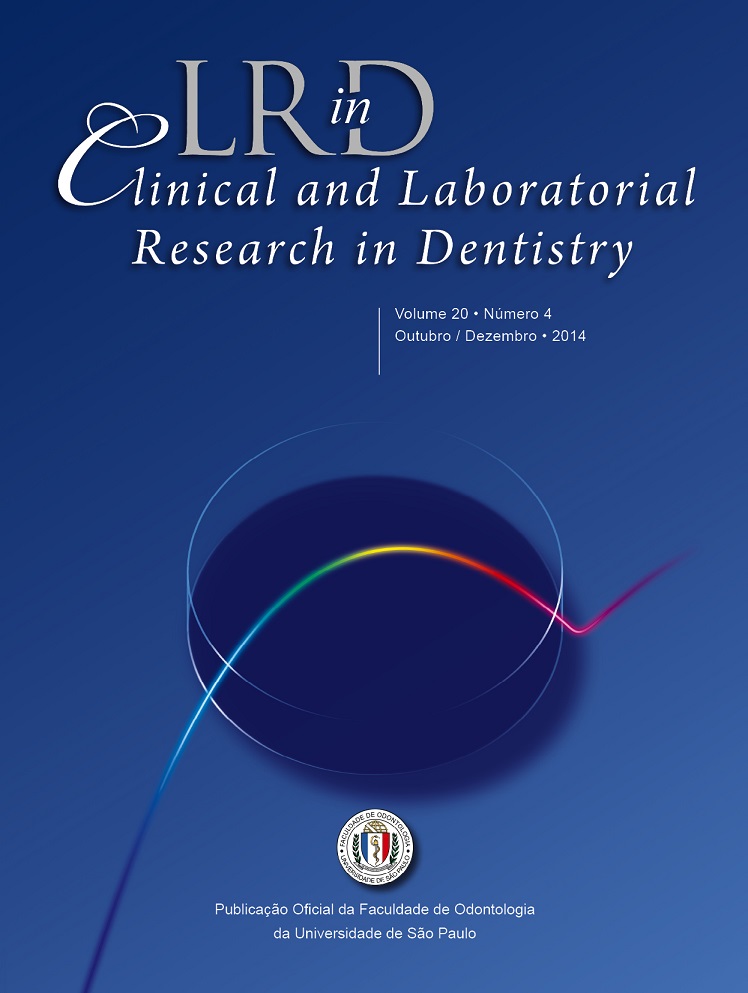Prevalence of the developmental bone defect of the mandible in cone-beam computed tomography scans
DOI:
https://doi.org/10.11606/issn.2357-8041.clrd.2014.82783Keywords:
Odontogenic Cysts, Cone-Beam Computed Tomography, Prevalence.Abstract
The developmental bone defect of the mandible is a bone cavity presenting as a well-defi ned, radiolucent lesion, located in the posterior region of the mandible, just below the inferior dental canal and above the mandibular base. It is asymptomatic, has a greater predilection for males, and a prevalence between 0.1% and 0.48%. The aim of this study was to conduct a review of the literature on the prevalence of this bone defect and compare the literature data to that of an assessment conducted of routine cone-beam computerized tomography (CBCT) scans from a radiological clinic. The use of diagnostic resources such as cone-beam volumetric tomography was also highlighted. CBCT routine scans taken from July 1st, 2012 to September 27, 2012 were retrieved from the digital archives of a private dental radiology clinic and evaluated, for a total of 1,344 CBCT images. Stafne’s cavity was observed In 22 cases (0.16%). Among the 19 male cases, 15 were Type I, 3 were Type II and 1 was Type III, according to Ariji’s classifi cation.5 All of the 3 female cases (the male-to-female ratio was 6.33:1) were Ariji Type I. The fi ndings of this study were consistent with those from the literature consulted, in that the highest prevalence rates were observed for unilateral, Ariji Type I lesions and in the male gender.Downloads
References
Stafne EC. Bone cavities situated near the angle of the mandible. J Am Dent Assoc 1942;29:1969-72.
Münevveroglu AP, Aydin KC. Stafne bone defect: report two cases. Case reports in Dentistry 2012.
Herranz-Aparicio J, Figueiredo R, Gay-Escoda C. Stafne’s bone cavity: an unusual case with involvement of the buccal and lingual mandibular plates. J Clin Exp Dent 2014; 6(1):e96-9.
Schneider T, Filo K, Locher MC, Gander T, Metzler P, Grätz KW, Kruse AL, Lübbers HT. Stafne bone cavities: systematic algorithm for diagnosis derived from retrospective data over a 5-year period. British Journal of Oral and Maxillofacial Surgery 2014, 52: 369–374.
Ariji E, Fujiwara N, Tabata O, Nakayama E, Kanda S, Shiratsuchi Y, Oka M. Stafne’s bone cavity. Classification based on outline and content determined by computed tomography. Oral Surg Oral Med Oral Pathol 1993;76:375–80.
Kao HY, Huang IYE, Chen CM, Wu CW, Hsu KJ, Chen CM. Late mandibular fracture after molar extraction. J Oral Maxillofac Surg 2010, 68:1698-1700.
Boffano P, Gallesio C, Daniele D, Roccia F. An unusual trilobite Stafne bone cavity. Surg Radiol Ana. 2013, 35:351-353.
Quesada-Gómez C, Valmaseda-Castellón E, Berini-Aytés L, Gay-Escoda C. Stafne bone cavity: a retrospective study of 11 cases. Med Oral Patol Oral Cir Bucal 2006 May 1;11(3):E277-80.
Philipsen HP, Takata T, Reichart PA, Sato S, Suei Y. Lingual and buccal
mandibular bone depressions: a review based on 583 cases from a world-wide
literature survey, including 69 new cases from Japan. Dentomaxillofac Radiol
;31(5):281-90.
Sisman Y, Miloglu O, Sekerci AE, Yilmaz AB, Demirtas O, Tokmak TT. Radiographic evaluation on prevalence of Stafne bone defect: a study from two
centres in Turkey. Dentomaxillofac Radiol 2012 Feb;41(2):152-8.
Courten A, Küffer R, Samson J, Lombardi T. Anterior lingual mandibular salivary gland defect (Stafne defect) presenting as residual cyst. Oral Surg Oral Med Oral Pathol Oral Radiol Endod 2002, 94:460-64
Karmiol M, Walsh RF. Incidence of static bone defect of the mandible. Oral Surg Oral Med Oral Pathol 1968; 26:225–28.
Sisman Y, Etöz OA, Mavili E, Sahman H, Ertas ET. Anterior Stafne bone defect mimicking a residual cyst: a case report. Dentomaxillofacial Radiology 2010 39, 124–126.
Minowa K, Inoue N, Izumiyama Y, Ashikaga Y, Chu B, Maravilla KR, Totsuka Y, Nakamura M. Static bone cavity of the mandible: Computed tomography findings with histopathologic correlation. Acta Radiol 2006 Sep;47(7):705-9.
Shimizu M, Osa N, Okamura K, Yoshiura K. CT analysis of the Stafne's bone defects of the mandible. Dentomaxillofac Radiol 2006 Mar;35(2):95-102.
Minowa K, Inoue N, Sawamura T, Matsuda A, Totsuka Y, Nakamura M. Evaluation of static bone cavities with CT and MRI. Dentomaxillofac Radiol 2003 Jan;32(1):2-7.
Flores Campos PS, Oliveira JA, Dantas JA, de Melo DP, Pena N, Santos LA, Crusoé-Rebello IM. Stafne's Defect with Buccal Cortical Expansion: A Case Report. Int J Dent 2010; 2010:515931.
Barker GR. A radiolucency of the ascending ramus of the mandible associated with invested parotid salivary gland material and analogous with a Stafne bone cavity. Br J Oral Maxillofac Surg 1988 Feb;26(1):81-4.
Dereci O, Duran S. Intraorally exposed anterior Stafne bone defect: a case report. Oral and Maxillofacial Surgery 2012, n.5, v.113.
Downloads
Published
Issue
Section
License
Authors are requested to send, together with the letter to the Editors, a term of responsibility. Thus, the works submitted for appreciation for publication must be accompanied by a document containing the signature of each of the authors, the model of which is presented as follows:
I/We, _________________________, author(s) of the work entitled_______________, now submitted for the appreciation of Clinical and Laboratorial Research in Dentistry, agree that the authors retain copyright and grant the journal right of first publication with the work simultaneously licensed under a Creative Commons Attribution License that allows others to share the work with an acknowledgement of the work's authorship and initial publication in this journal. Authors are able to enter into separate, additional contractual arrangements for the non-exclusive distribution of the journal's published version of the work (e.g., post it to an institutional repository or publish it in a book), with an acknowledgement of its initial publication in this journal. Authors are permitted and encouraged to post their work online (e.g., in institutional repositories or on their website) prior to and during the submission process, as it can lead to productive exchanges, as well as earlier and greater citation of published work (See The Effect of Open Access).
Date: ____/____/____Signature(s): _______________


